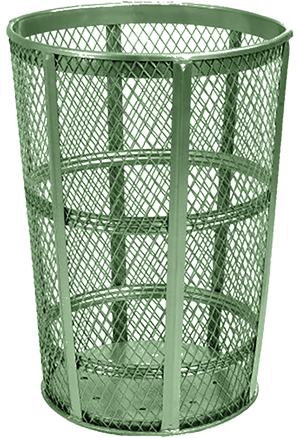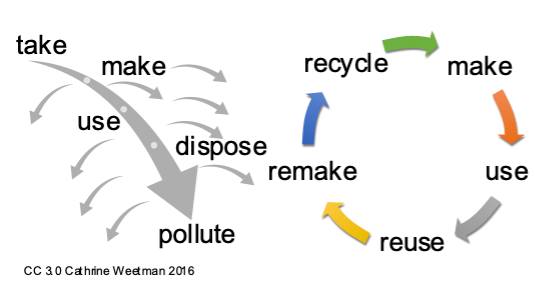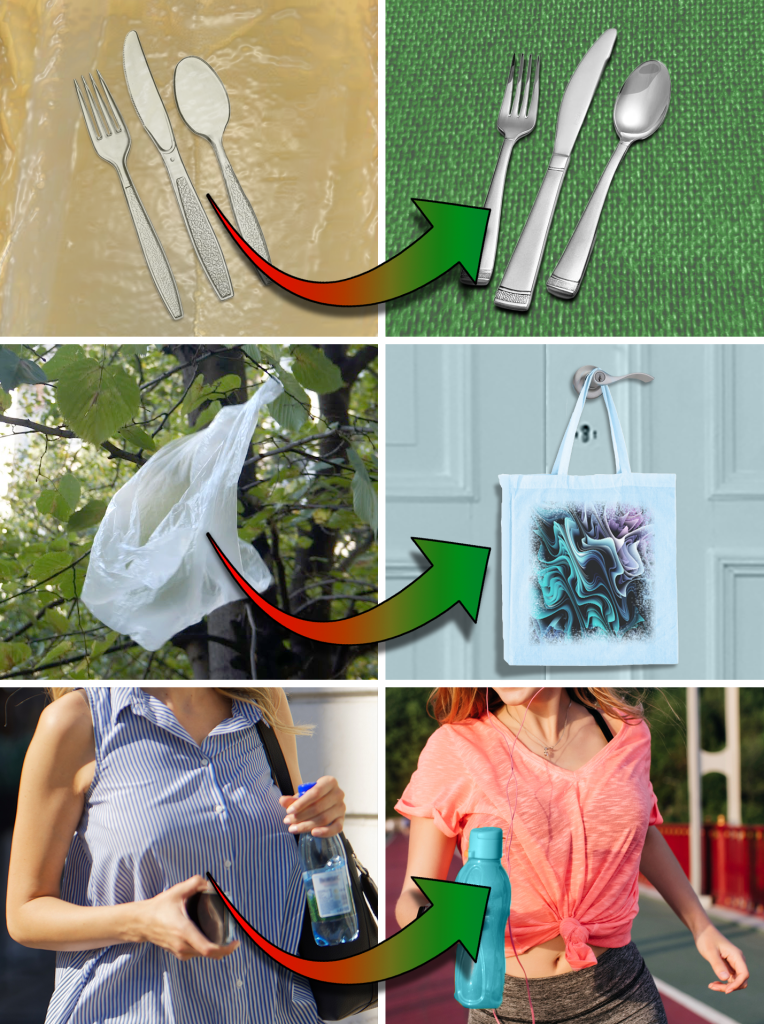—a guest post from Media resident, David Director
Zero waste—Are you kidding me? How is that even a thing?

But it is, and it’s not as crazy as you may think, and it’s not just an aspirational goal. In fact, it’s a whole international movement, the Zero Waste International Alliance, a network of advocates from around the globe.
Zero Waste is about re-thinking our approach to how we make, sell, use, and dispose of goods in our society. Since the dawn of history, or at least as long as we’ve been digging stuff up out of the ground, man has relied on a “linear” model of consumption, starting with extraction (metal ores, fossil fuels), through manufacture, packaging, transportation, and distribution, and finally to consumption and disposal of non-consumable components, otherwise called “waste.” Zero Waste aims to change that model, to a “circular” one, where disposal cycles back to replace or supplement extraction. The graphic below shows the difference.

Homo sapiens is the only species on the planet that creates waste. For all other creatures, anything they leave behind is (mostly) food, or some other useful material (e.g. shelter) for some other living thing, often for many others. Nature wastes nothing, but humans do.

The Zero Waste paradigm turns around that consumption model, beginning with re-thinking and redesigning systems to avoid needless or wasteful consumption. “Do I really need another [fill in the blank]?” If so, is it produced from renewable or recycled materials, and can it be recycled or repurposed when it reaches the end of its useful life? And does it have a reasonable useful life in the first place, or will it wear out in a couple of years?
Once we’ve gotten that far, the familiar Reduce-Reuse-Recycle (and we can add Compost to the latter category, as food waste is the easiest to recycle) will take us further along the path to a circular economy. But not all the way, unfortunately. Even after all the reusing and recycling is done, we still wind up with materials that are hard to recycle, often because they are composites of multiple materials. These require a further step of processing, called materials recovery, in order to return their raw materials to the economy in a useful form.
And finally, there remains some portion of the waste materials that simply cannot be reused or recycled in any way, usually because they are contaminated or otherwise harmful (e.g. medical waste). These must be stabilized and buried in a manner designed to keep them contained for the long term. Critically, the Zero Waste paradigm specifies that ultimate disposal be “…without burning and with no discharges to land, water, or air that threaten the environment or human health.”

Sounds complicated. Where do ordinary folks like me fit in?
Good question. It turns out there is plenty for all of us to do, and in fact, it’s the critical part. See that blue bar at the top, the one labeled “Rethink/Redesign”? That’s for us to do as consumers: to re-think what we buy, why we buy it, and how it’s made. It’s about deciding whether it’s best to buy an item new, or to acquire it used, or perhaps, do we really need it at all? And then, if we do decide to buy, is the product responsibly produced, with a minimum of environmental impact? What will happen to it when it’s outlived its usefulness?
The good news here is, if we as consumers change our purchasing habits, companies will redesign their products to match what we want to buy. They will reduce waste, use more sustainably-produced materials (because, ultimately, it costs less), and shrink everyone’s environmental footprint.
What about the bottom of the chart? How do we get there?

Here in Pennsylvania, waste disposal is largely the responsibility of the counties, except for industrial sites. In Delaware County, that task is handled by the Delaware County Solid Waste Authority (DCSWA).
Currently, trash is collected by municipalities and private haulers and taken either to the ReWorld (formerly Covanta) incinerator in Chester, or, for more distant locations, to one of two transfer stations owned by the county and operated by DCSWA, where it is loaded onto larger trucks for transport either to (mostly) ReWorld or (sometimes) to the County-owned landfill in Rolling Hills, Berks County. The ReWorld incinerator, and the County’s use of it, has been a matter of controversy for decades, and will need to be addressed. One way to do this is to support the work of CRCQL (Chester Residents Concerned for Quality Living) who are working to draw attention to the environmental justice issues of the incinerator and other polluting industries concentrated in the Chester waterfront.
As part of the state-mandated 10-year planning effort for waste disposal, the County conducted a comprehensive analysis and planning process intended to guide future efforts toward a Zero Waste future. That plan, currently in final review, is expected to be released by the end of this year. We’ll keep you posted.
Where can I learn more?
For further information, visit the Zero Waste International Alliance website, at https://zwia.org/.

The shift from a linear to a circular economy is such a game-changer! Instead of just taking, using, and tossing, Zero Waste challenges us to rethink how we design, consume, and dispose of products. It’s inspiring to see that this isn’t just an idealistic dream but a global movement with real solutions. The idea of cycling materials back into use instead of relying on endless extraction makes so much sense—both for the planet and for future generations. It’s a mindset shift, but one that can lead to lasting change!